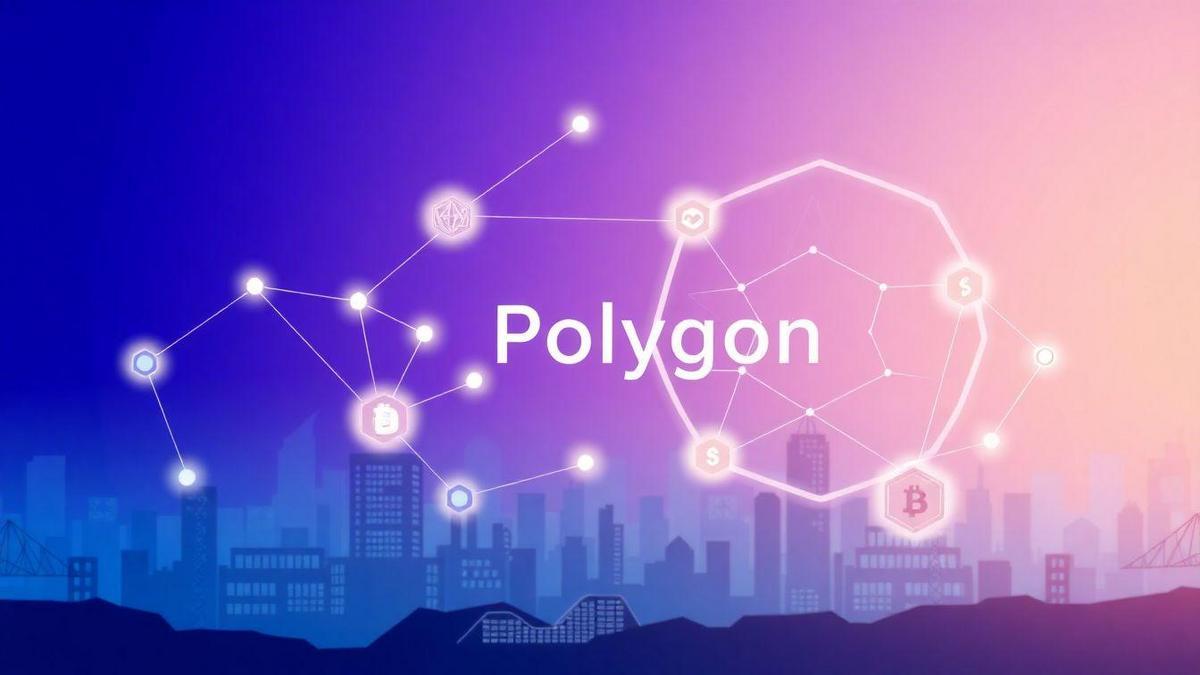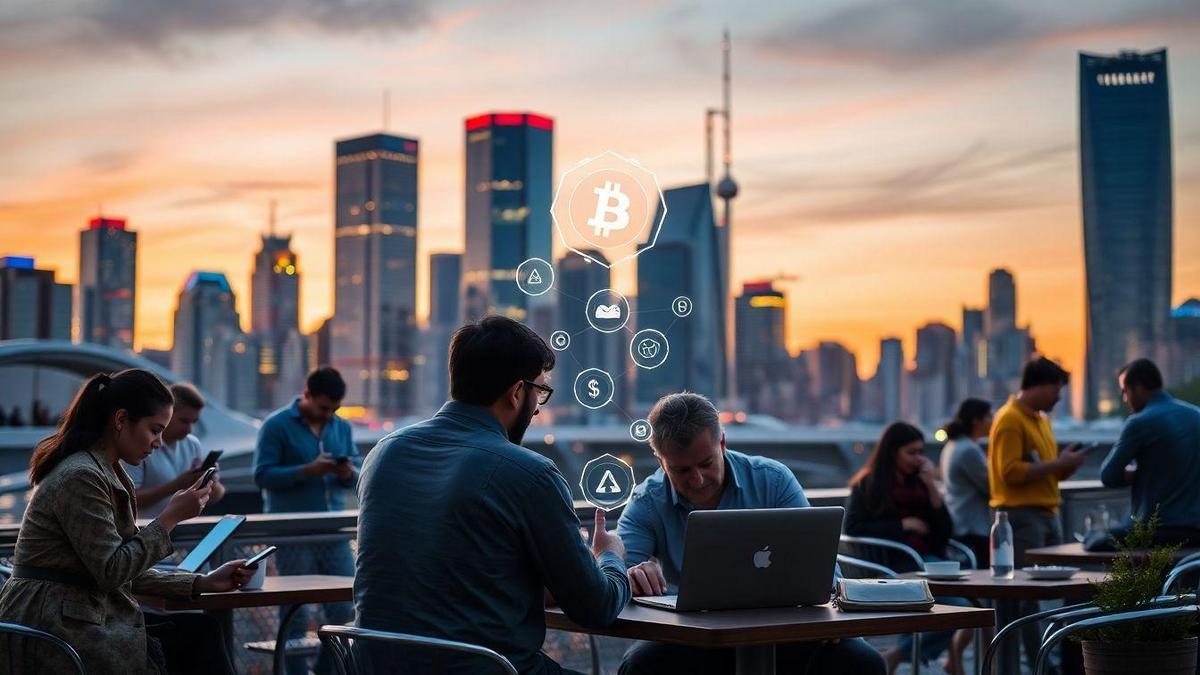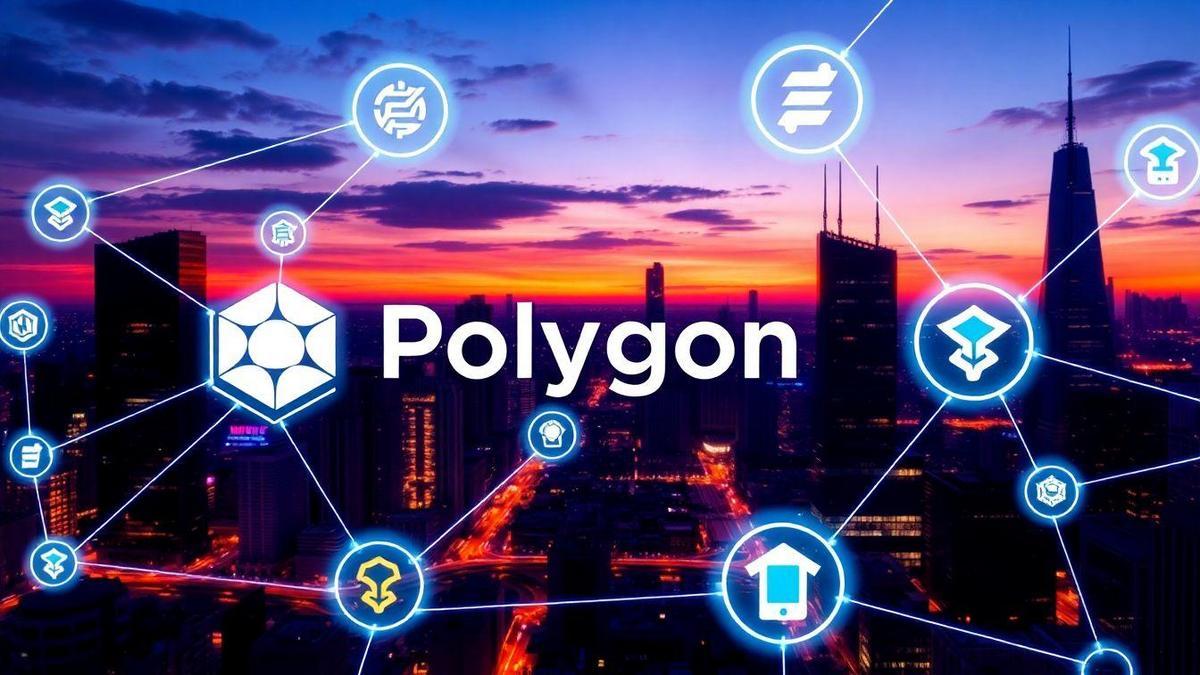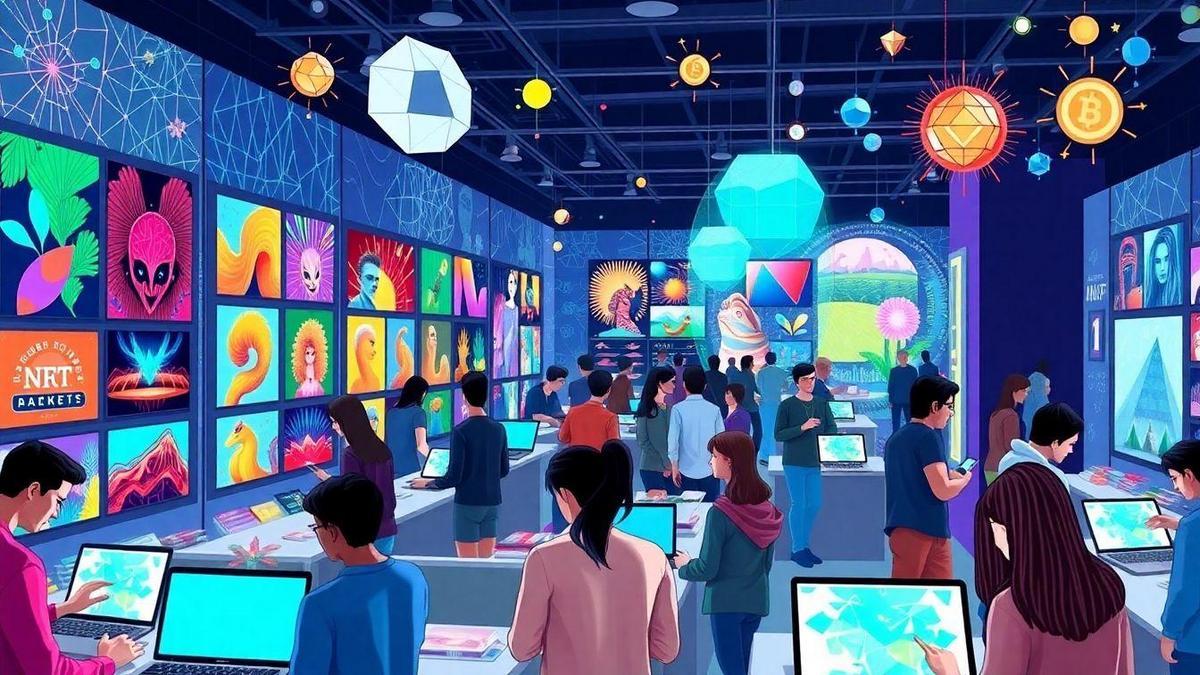Have you heard about Polygon Crypto? It’s making waves in the blockchain world. In this article, you’ll discover what Polygon is and how it speeds up transactions, cuts fees, and connects different blockchains. We’ll break down the role of the MATIC token and why it’s crucial for users. Get ready to explore amazing decentralized applications (DApps) and the future of NFT marketplaces on Polygon. Whether you’re a beginner or a seasoned crypto pro, there’s something here for you!
Main Points to Remember
- Polygon helps make blockchain faster and cheaper.
- It connects different blockchains easily.
- Users can enjoy quick transactions without delays.
- More people can join the blockchain world with Polygon.
- Developers can create new apps more easily with its tools.

What is Polygon Crypto and How Does It Work?
Understanding the Basics of Polygon
Polygon Crypto is like a bridge that connects different blockchains, making it easier for them to work together. Think of it as a friendly translator that helps different languages communicate. It helps speed up transactions and lowers costs, which is a big deal in the world of cryptocurrencies.
Here are some key points about Polygon:
- Scalability: It helps Ethereum handle more transactions at once.
- Interoperability: Different blockchains can talk to each other easily.
- User-Friendly: It’s designed to be simple for developers and users alike.
How Polygon Fits into the Ethereum Ecosystem
Polygon is built on top of Ethereum, which is one of the biggest platforms for cryptocurrencies. It takes what Ethereum offers and makes it better. Imagine Ethereum as a busy highway with lots of traffic. Polygon acts like a side road that helps cars (transactions) move faster and with less hassle.
Here’s how Polygon plays its part:
| Feature | Ethereum | Polygon |
|---|---|---|
| Transaction Speed | Slower due to congestion | Much faster |
| Transaction Cost | Higher fees | Lower fees |
| Compatibility | Limited | Highly compatible |
The Role of MATIC Token in Polygon
MATIC is the main token used in the Polygon network. It’s like the currency you use to pay for things in a store. You need MATIC to pay for transactions and to help keep the network running smoothly.
Here’s what MATIC does:
- Transaction Fees: You use MATIC to pay for each transaction.
- Staking: You can hold MATIC to help secure the network and earn rewards.
- Governance: MATIC holders can vote on changes to the network.
In short, MATIC is essential for everything that happens in the Polygon ecosystem.

The Importance of Blockchain Scalability
Why Scalability Matters for Crypto Users
When you dive into crypto, you might hear the term scalability thrown around a lot. But what does it really mean for you? Simply put, scalability is all about how well a blockchain can handle a growing number of transactions. Imagine a busy highway: if too many cars are on the road, traffic slows down, and everyone gets frustrated. The same goes for blockchains. If they can’t keep up with the demand, your transactions can take longer, and fees can skyrocket.
How Polygon Improves Transaction Speed
Now, let’s talk about Polygon Crypto. Think of Polygon as the fast lane on that highway. It helps speed up transactions and makes everything run smoother. By using layer 2 scaling solutions, Polygon allows for quicker processing times. This means that when you send or receive crypto, it happens almost instantly. You don’t want to wait around, right?
Here’s a quick comparison of transaction speeds:
| Blockchain | Average Transaction Speed | Polygon |
|---|---|---|
| Bitcoin | 10 minutes | 2 seconds |
| Ethereum | 15 seconds | 1-2 seconds |
| Polygon | Instant | Instant |
Reducing Transaction Fees with Polygon
Another great thing about Polygon is how it helps lower transaction fees. High fees can be a real buzzkill, especially if you’re trying to make small transactions. With Polygon, fees can be reduced significantly, making it more affordable for you to send and receive crypto.
To put it simply, here’s how Polygon makes your crypto life easier:
- Faster Transactions: Get your transactions done in a snap.
- Lower Fees: Keep more money in your pocket.
- Better Experience: Enjoy a smoother ride in the crypto world.

Exploring Ethereum Layer 2 Solutions
What Are Layer 2 Solutions?
Layer 2 solutions are like a shortcut for Ethereum. They help make transactions faster and cheaper. Think of it as a fast lane on a busy highway. Instead of waiting in long lines, you can zoom through. These solutions sit on top of the Ethereum blockchain, allowing more transactions to happen without slowing down the main network.
Some key points about Layer 2 solutions:
- Speed: They process transactions quickly.
- Cost: They lower fees, making it cheaper to use Ethereum.
- Scalability: They allow more people to use Ethereum without causing congestion.
How Polygon Serves as an Ethereum Layer 2 Solution
Polygon is one of the top players in the Layer 2 game. It acts like a bridge, connecting people to Ethereum while making everything smoother. With Polygon, you can enjoy faster transactions and lower costs.
Here’s how Polygon shines:
| Feature | Polygon | Ethereum |
|---|---|---|
| Transaction Speed | Up to 7,000 transactions per second | Around 15 transactions per second |
| Transaction Cost | Less than a cent | Can be several dollars |
| User Experience | Smooth and fast | Can be slow during busy times |
Polygon makes it easy for developers to create apps. They can build on Polygon and then connect to Ethereum. This means more options for users and developers alike.
Benefits of Using Layer 2 for Smart Contracts
Using Layer 2 solutions like Polygon for smart contracts comes with many perks. Here are a few benefits you might find exciting:
- Lower Fees: You can save money on transaction costs.
- Faster Execution: Smart contracts run quickly, so you don’t have to wait long.
- More Users: With lower fees and faster speeds, more people can join in.
Imagine you’re buying a digital collectible. With Layer 2, you can complete your purchase in seconds and for a fraction of the cost. That’s the beauty of Polygon Crypto!

Decentralized Applications on Polygon
What Are Decentralized Applications?
Decentralized Applications, or DApps, are apps that run on a blockchain instead of a single computer or server. Think of them like a community garden. Everyone can contribute, and no one person controls it. This makes DApps transparent and secure. They can be anything from games to finance tools, all built to give you more control over your data.
Popular DApps Built on Polygon
Polygon is becoming a favorite spot for developers to create DApps. Here are a few popular ones:
| DApp Name | Description |
|---|---|
| Aavegotchi | A game that combines crypto with digital pets. |
| QuickSwap | A decentralized exchange for trading tokens. |
| Decentraland | A virtual world where you can buy land and create. |
These DApps are not just fun; they also offer you ways to earn and interact with others in the crypto space.
How Polygon Enhances DApp Performance
Polygon boosts DApp performance in several ways. Here’s how:
- Speed: Transactions happen quickly, so you don’t have to wait long.
- Low Fees: You save money on transaction costs, making it easier to use DApps without worrying about high fees.
- Scalability: More users can join without slowing things down. It’s like having a bigger party space for all your friends!
By using Polygon, developers can create DApps that are more efficient and user-friendly. This means you can enjoy a smoother experience while exploring the exciting world of Polygon Crypto.

Blockchain Interoperability with Polygon
What is Blockchain Interoperability?
Blockchain interoperability is like a bridge connecting different islands. Imagine you have several islands (blockchains) that can’t talk to each other. Interoperability lets them share information and work together. This means you can send tokens or data from one blockchain to another without any hiccups. It’s all about making sure that everything flows smoothly, just like a well-oiled machine.
How Polygon Connects Different Blockchains
Polygon is a game-changer in the world of blockchain. It acts as a layer 2 scaling solution that helps different blockchains communicate. Think of it as a translator that helps two people who speak different languages understand each other.
Here’s how it works:
| Feature | Description |
|---|---|
| Scalability | Polygon allows blockchains to process more transactions at once. |
| Low Fees | Transaction costs are cheaper, making it easier for users. |
| Security | Polygon uses strong security measures to keep everything safe. |
| Flexibility | Developers can create custom solutions that fit their needs. |
With Polygon, you can move assets and data across various blockchains without breaking a sweat. It’s all about creating a seamless experience for users and developers alike.
The Future of Interoperable Blockchains with Polygon
Looking ahead, the future of interoperable blockchains with Polygon seems bright. As more blockchains join the party, the possibilities are endless. You’ll be able to access a wider range of services and applications.
Imagine a world where you can easily trade assets, share information, and build applications across different blockchains. That’s what Polygon is working towards! It’s like having a universal remote for all your devices, making everything simpler and more connected.

The Role of Proof of Stake in Polygon
What is Proof of Stake?
Proof of Stake (PoS) is a way to secure a blockchain. Instead of using a lot of energy to solve complex puzzles like Proof of Work (PoW), PoS lets users “stake” their coins. This means you lock up some of your cryptocurrency to help keep the network safe. In return, you can earn rewards. Think of it like putting money in a savings account and getting interest.
How Polygon Uses Proof of Stake
Polygon is a platform that makes Ethereum faster and cheaper to use. It uses PoS to help with this. Here’s how it works:
- Staking: You can stake your Polygon Crypto (MATIC) to help validate transactions. The more you stake, the more you can earn.
- Validators: People who stake their coins become validators. They check and confirm transactions on the network.
- Rewards: Validators earn rewards for their work, which encourages more people to stake their coins.
Here’s a simple table to show how it all works:
| Step | Action | Outcome |
|---|---|---|
| 1 | Stake MATIC | Help secure the network |
| 2 | Become a Validator | Confirm transactions |
| 3 | Earn Rewards | Get paid for your work |
Benefits of Proof of Stake for Users
Using PoS in Polygon comes with some great perks for you:
- Lower Costs: Since it uses less energy, fees are lower.
- More Rewards: Staking allows you to earn more MATIC over time.
- Faster Transactions: The network processes transactions quicker, making everything smoother.
Imagine you’re at a coffee shop. If the line is long (like PoW), you might get frustrated waiting. But if the line moves quickly (like PoS), you can enjoy your coffee sooner. That’s the beauty of Polygon’s use of Proof of Stake.

The Rise of NFT Marketplaces on Polygon
What Are NFTs and How Do They Work?
NFTs, or Non-Fungible Tokens, are like digital collectibles. Imagine owning a one-of-a-kind baseball card, but online! Each NFT is special and can’t be swapped for another NFT of equal value. They can represent art, music, videos, and even virtual real estate. When you buy an NFT, you get proof of ownership stored on a blockchain, which is a secure digital ledger. This makes it easy to verify who owns what.
Why Use Polygon for NFT Marketplaces?
Now, you might wonder, why choose Polygon Crypto for NFTs? Well, it boils down to a few key reasons:
- Low Fees: Transactions on Polygon are cheaper compared to other blockchains. This means you can buy and sell NFTs without breaking the bank.
- Fast Transactions: Polygon is speedy! You won’t have to wait long for your transactions to go through.
- Eco-Friendly: Polygon uses less energy, making it a greener choice for your digital assets.
These factors make Polygon a smart option for NFT marketplaces.
Popular NFT Marketplaces on Polygon
Here’s a quick look at some of the popular NFT marketplaces you can explore on Polygon:
| Marketplace | Description |
|---|---|
| OpenSea | One of the largest platforms for buying and selling NFTs. |
| Rarible | A community-driven marketplace where you can create and sell NFTs. |
| Mintable | A user-friendly platform for minting and trading NFTs. |
| Zed Run | A unique marketplace for digital horse racing NFTs. |
These platforms allow you to dive into the exciting world of NFTs on Polygon, making it easier than ever to start your collection.

The Future of Polygon Crypto in 2025
Predictions for Polygon’s Growth
As we look ahead to 2025, many experts believe that Polygon Crypto will see significant growth. With the rise of decentralized finance (DeFi) and the increasing demand for scalable solutions, Polygon is well-positioned to thrive. Here are some key predictions:
- User Adoption: More people will start using Polygon for transactions and dApps. This means you could see a lot more activity on the network.
- Market Value: Analysts expect the value of Polygon to increase as more projects choose to build on its platform.
- Partnerships: Collaborations with major companies could lead to new use cases and expand Polygon’s reach.
Upcoming Features and Developments
Polygon is always working on new features to make the platform better. Here are some exciting developments you can look forward to:
| Feature | Description | Expected Release |
|---|---|---|
| zk-Rollups | A technology that speeds up transactions and cuts costs | Early 2025 |
| Enhanced Security | New protocols to keep your assets safe | Mid 2025 |
| Interoperability | Better connections with other blockchains | Late 2025 |
These features are designed to make your experience smoother, faster, and more secure.
How You Can Get Involved with Polygon
Getting involved with Polygon Crypto is easier than you might think! Here’s how you can jump in:
- Invest: Consider buying some MATIC tokens to start your journey.
- Explore dApps: Try out various decentralized applications built on Polygon. You might find some that fit your needs.
- Join the Community: Engage with other users on forums or social media. Sharing insights can help you learn more.
By taking these steps, you can be part of Polygon’s exciting future!

How to Start Using Polygon Crypto Today
Setting Up a Wallet for MATIC
Getting started with Polygon Crypto begins with setting up a wallet to store your MATIC tokens. Think of your wallet as a digital bank account. Here’s how you can set it up:
- Choose a Wallet: You can go for a software wallet like MetaMask or a hardware wallet like Ledger. Software wallets are easy to use, while hardware wallets offer more security.
- Download and Install: If you pick a software wallet, download the app from the official website or app store. Follow the instructions to install it.
- Create Your Wallet: Open the app and create a new wallet. Make sure to write down your recovery phrase and keep it safe. This phrase is like a key to your wallet.
- Add MATIC to Your Wallet: Once your wallet is set up, you can receive MATIC tokens. Just find your wallet address and share it when someone sends you MATIC.
Buying and Trading MATIC Tokens
Now that you have your wallet, it’s time to buy and trade MATIC tokens. Here’s a simple way to do it:
- Choose an Exchange: Look for a cryptocurrency exchange that supports MATIC, like Binance or Coinbase.
- Create an Account: Sign up for an account on the exchange. You may need to verify your identity.
- Deposit Funds: Deposit money into your exchange account using a bank transfer or credit card.
- Buy MATIC: Search for MATIC on the exchange and place an order to buy. You can choose a market order for quick buying or a limit order to set a specific price.
- Transfer to Your Wallet: After buying MATIC, transfer it to your wallet for safekeeping.
Tips for Navigating the Polygon Ecosystem
Navigating the Polygon ecosystem can feel like learning a new game. Here are some tips to help you play it right:
- Stay Updated: Follow Polygon’s social media and forums. This way, you’ll hear about new features and updates.
- Explore dApps: Polygon supports many decentralized applications (dApps). Try them out to see what you like best.
- Join Communities: Engage with other users on platforms like Discord or Reddit. You can learn a lot from their experiences.
- Practice Caution: Always do your research before investing. The crypto world can be unpredictable.
| Tip | Description |
|---|---|
| Stay Updated | Follow Polygon’s news and updates. |
| Explore dApps | Try different decentralized applications. |
| Join Communities | Connect with other users for tips and tricks. |
| Practice Caution | Research before making any investment. |
Conclusion
In summary, Polygon Crypto is a game-changer in the blockchain landscape. It enhances transaction speed, reduces fees, and fosters interoperability among various blockchains. Whether you’re a newcomer or a seasoned trader, Polygon offers a wealth of opportunities to explore. With its user-friendly features and the essential role of the MATIC token, you can navigate this vibrant ecosystem with ease. So, why not take the plunge? Dive into the exciting world of Polygon and see how it can transform your crypto experience. For more insights and articles, don’t forget to check out shopfinancia.com!
Frequently Asked Questions
What is Polygon Crypto?
Polygon Crypto is a tool that helps Ethereum work faster and cheaper. It makes blockchain transactions quick and easy. You can think of it as a highway for crypto.
How does Polygon improve blockchain scalability?
Polygon boosts scalability by adding layers to the blockchain. These layers allow many transactions at once. It’s like having extra lanes on a busy road.
Why is Polygon important for crypto users in 2025?
In 2025, Polygon Crypto is key for lower fees and faster transactions. You want your trades quick, right? Polygon makes that possible!
Can I use Polygon with other cryptocurrencies?
Yes! Polygon works with different cryptocurrencies. You can swap and trade easily across many blockchains.
Is Polygon safe for my crypto transactions?
Yes, Polygon is designed to be secure. It has strong technology to protect your assets. So, you can trade with peace of mind!